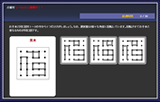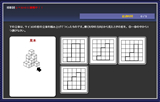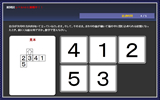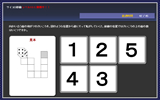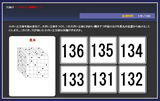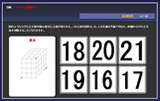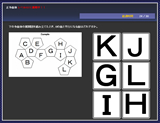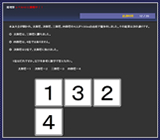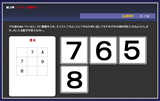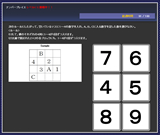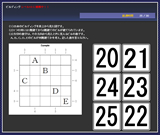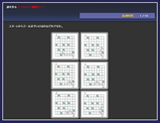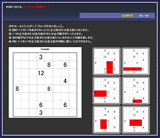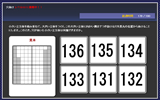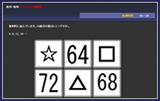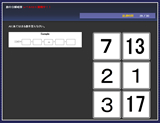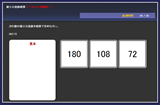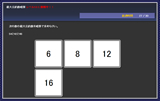- Home >
- Lesson Guide
Lesson Guide
Spatial Perception
【Sketch of the point】
Sketch of the point is a learning tool which is frequently used in a child education. Since it is a quite important learning material, elementary school children or older are recommended to continue working on it.
At a glance, it is thought that it just develops an ability towards figures. However, a right approach helps developing other important abilities.
(In many cases, those who are not good at sketch of the point are not good at Mathematics generally.)
【Paper folding】
Paper folding is a material that develops "a sense of symmetry" which is one of the important elements in a sense of flatness. Since a sense of flatness is just not only necessary to solve a question about plane figures, but also becomes a fundamental sense of the spatial perception, you are recommended to work on it hard. Additionally, 3 important things in a sense of flatness are as follows.
【Turn】
Rotation represents the training aid to foster the ‘’sense of rotation", which is one of the important elements in the sense of flatness. Though a bit harder than the sense of symmetry or the sense of parallelism, make sure to knuckle it down as it is an important sensation.
【Tile】
The tile represents very important item in the sense of flatness.
When solving problem of the tile, you must not use any formula of the area even if you know it.
【Projective figure】
Projection is a very important element in developing the foundation of the spatial perception.
It is an ideal way to use teaching tools, make the same shape and study comparing the real thing with the one on the screen.
【block】
In this item, "Block", build up small cubes and participants count them.
Along with the projection, it is an important item in developing the foundation of the spatial perception, but it also helps to make the spatial perception (imaginary ability) develop to a quite high level if the method below is applied.
【Development】
When you understood better (have become possible to imagine) in an order of "Projection" and "Block", it is a development to be worked on as a next step. The recommended approach to this question is to image that you are standing on the side of the arrow, then to think you are going to be shut up. If you cannot shorten the time or pass the examination, make various developments yourself, make questions using them, then check the answer using the developments you made.
【Dice move】
Dice move is a quit important item to gain a higher level of the spatial perception.
If you cannot get better (cannot image) on a computer screen, as well as other training, tray the "With actual thing => in your head => with actual thing => in your head" approach again and again.
【Drilling】
Drilling is a key point and an important question for gaining the spatial perception.
It sometimes takes a quite long time to be possible to solve. However, since it will certainly be possible if you keep trying, do not give up.
【Cutting】
The cutting, together with the "Dice Move" and "Drilling", represents one of the important items that serve as the key to develop high-level spatial perception.
Since the cutting is the item with high difficulty level, you should put it off and take other item until your spatial perception will have been developed to a certain level, after which you may work on the cutting.
【Regular polyhedron】
The polyhedron is the unit which you should tackle in the next stage after you became able to fully understand (to fully image in the mind) the "development chart".
Therefore, if you understand (image) the "development chart" insufficiently, it also affects the understanding (imaging) on the polyhedron sometimes. In such cases, attend the quick training of development chart before tackling with the polyhedron.
Logical hypothesis
【Deduction calculation】
It is a typical item to build up the logical thinking ability and hypothesis think ability through game play.
Although it is OK to make a figure and think just for solving a question, here, since, addition to a high level of the logical thinking ability and the hypothesis think ability, it also works as training to enhance imaginary ability, let participants solve questions without making a figure.
【Magic square】
Magic square is one of the mathematical puzzles, wherein you are required to find an answer which satisfies two or more conditions at the same time. Thus, by solving the magic square, you will develop multifaceted thinking ability and have so called "flexible mind".
【Equation without math symbols】
Equation without math symbols is one of the mathematical puzzles, wherein you are required to find an answer which satisfies two or more conditions at the same time. Thus, by solving the Equation without math symbols, you will develop multifaceted thinking ability and have so called "flexible mind".
【Number Place】
Number place is a mathematical puzzle that was born in Japan, and it is said to be the most popular game of its kind. (There are several names to it, for example, Sudoku.) It is a puzzle to find out the answers that satisfy multiple conditions simultaneously.
Thus, by solving the number place, you will develop multifaceted thinking ability and have so called "flexible mind".
【Building】
It is a mathematical puzzle that can develop the hypothetical thinking ability and the spatial perception. Since it is a puzzle that finds an answer applied to some conditions, solving a puzzle helps develop to think about some things from many angles at once.
In addition, in this building puzzle, since one is required to have an image of how tall the building is, various other abilities can be developed at the same time.
【Making a way】
The Making a way is the puzzle wherein you are required to find an answer which satisfies two or more conditions at the same time. Thus, through solving this puzzle, you will develop multifaceted thinking ability and have so called "flexible mind".
Make-the-way enables you to follow the pertinent process of "hypothesis → verification". In addition, your "ability to think ahead" will be developed as you imagine multiple directions in your mind.
【Divide into squares】
The division into square is the puzzle wherein you are required to find an answer which satisfies two or more conditions at the same time. Thus, through solving this puzzle, you will develop multifaceted thinking ability and have so called "flexible mind".
【Division of blocks】
Division of blocks is one of the puzzles to find answers that satisfy multiple conditions simultaneously. Thus, by trying puzzles, multifaceted thinking ability, which allows you to think of multiple things simultaneously, will be developed, and you will become so-called "flexible mind".
Amount
【Volume calculation】
The "sense of volume" means the sense of imaging the numbers as the volume.
【A sense of fraction】
While the "Mental arithmetic of Mass perception" provides the training to image numbers as the volume, the sense of fraction also provides the training to image common fractions as the volume.
【Progression, rule】
In the progression & rule, you will be shown an incomplete schematic figure and will be trained to image in your mind what is beyond there.
And, in line with that, you will also be trained to find (image) the rule thereof in your mind.
【Mental arithmetic of decomposition of numbers 】
In the mental calculation of numeric decomposition, you will be trained to further enhance the "sense of volume" and to become strong with numbers as it develops your number sense (the ability to decompose and compose numbers).
【Mental arithmetic of the lowest common multiple 】
LCM mental calculation represents the development and application of "mental calculation of numeric decomposition", by which to find the least common multiple using the fragments decomposed from the numbers. Thus, once you became able to do the "mental calculation of numeric decomposition" to a certain degree, try to find the least common multiple in your head.
【Mental arithmetic of the greatest common divisor】
Mental arithmetic of the greatest common multiple is the application and development of "Mental arithmetic of decomposition of numbers" in which the greatest common multiple is obtained by making use of decomposed numbers. For the reason, it is advisable to work on the greatest common multiple only after you have become good at "Mental arithmetic of decomposition" to some extent.


